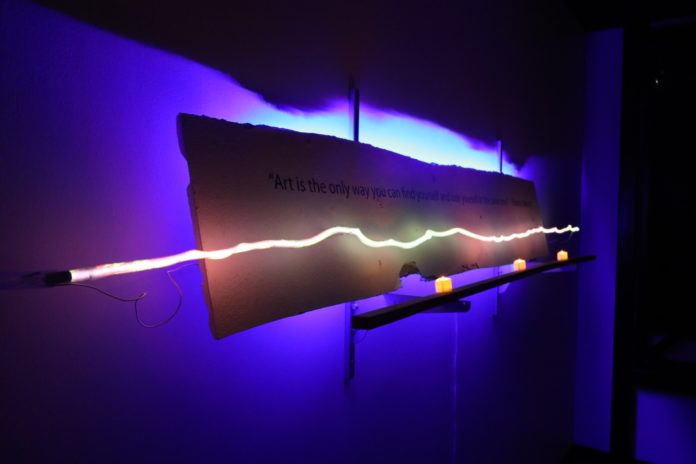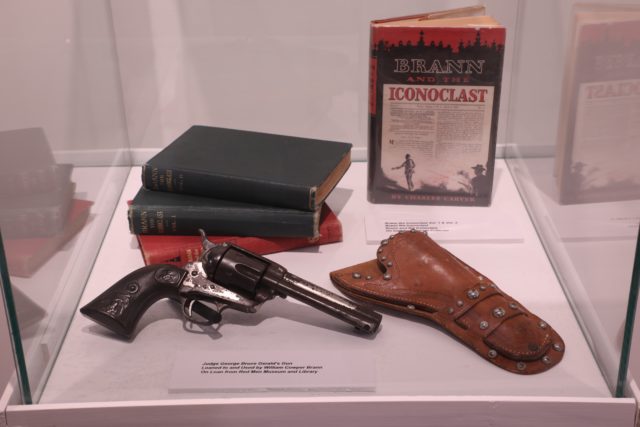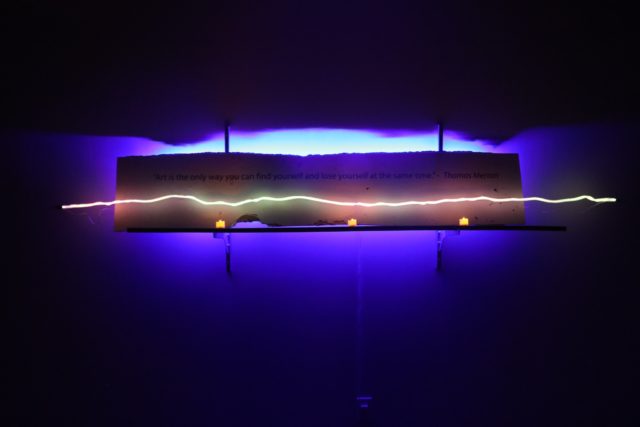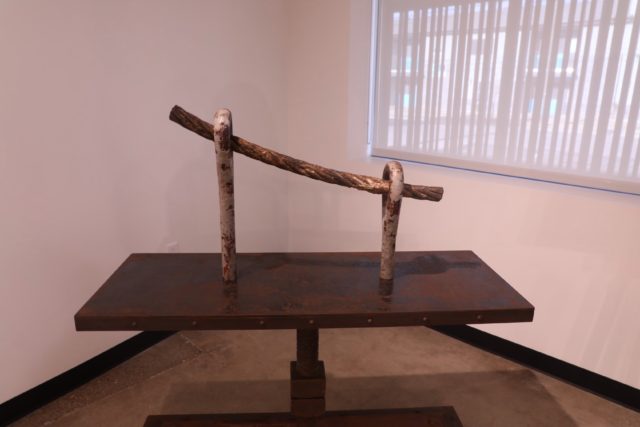
By Avery Ballmann | Staff Writer
Art Center Waco’s newest exhibit marvels at the lesser-known past of Waco. Austin artist Ben Livingston has created a tale of stories through photographs, artifacts and neon glass work.
This exhibit, entitled “Spirit Houses, Ghosts, and Memory,” will be at Art Center Waco until April 23 and is free and open to the public. When you visit the exhibit, be sure to enter from the entrance on the side on Ninth Street to view it in correct order.
“Spirit Houses, Ghosts, and Memory” is a site-specific traveling art exhibit, where Livingston ventures to a Texas town to uncover events and antiques that are left in the dust to then showcase as art.
“There is a lot of Waco’s underbelly I have dug up that is in the show that Wacoans probably don’t like to talk about,” Livingston said. “Maybe it’s a little uncomfortable, delightful or maybe it’s where their grandfather worked — who knows.”
Walking through the exhibit, you first see photos and infographics line the walls. A grim piece, encased in a clear box, is a gun that killed a local journalist and Baylor partisan in 1898.
William Cowper Brann wrote in a magazine named “The Iconoclast,” which can be seen in the encasing, and was notorious for his outlandish opinions, which eventually led to his own demise.
One example of Brann’s writing that eventually took a turn is when Brann wrote an article about a woman from Baylor and how much he loathed the Baptists. The woman’s father ambushed Brann on fourth street, shooting him in the back. Brann fired back with his Colt .45 pistol, which was given to him by a local banker. Both parties ended up dying from their injuries the following day.
Other events such as the Gay Raid in 1953 and The Reservation house, a red-light district in Waco, artifacts are featured in this space to give light to all of Waco’s history — even if it is uncomfortable to some.
“So by traveling, instead of going to a museum where they bring stuff in from somewhere else, I’m serving up a really interesting part of the community,” Livingston said.
Moving forward through the exhibit, behind the wall of black curtains is the neon artwork. Livingston creates spirit houses, which are small structures to honor ancestors and are primarily found in Southeast Asia. A twist to Livingston’s houses is that the spirit lies within the colorful neon glass and artifacts he encounters.
Although the night before the opening, Livingston felt the exhibit wasn’t complete. At 2 a.m. he visited the old Art Center, next to McLennan Community College, and he saw a vinyl quote that radiated through the abandoned building.
It was Thomas Merton’s quote: “Art is the only thing you can lose yourself in and find yourself in at the same time.” Merton was a monk and writer during the 20th century.
Livingston decided that this piece would complete the show. He carved out this piece of the wall and created a spirit house within it. He believes that this was their mantra and so he donated this spirit house to the current Art Center Waco.
A different piece in the neon space used a cable from Waco’s Suspension Bridge, as artisan blacksmith sculptor Skip Ralls created “Roebling’s Nuts.” A featured piece within the exhibit, Ralls was able to use material that many Wacoans can recognize within the sculpture.
“We [Livingston and Ralls] were eating lunch in the sun and I said ‘Hold on a second,’ I grabbed some other components off the bridge I have in New York,” Ralls said. “Put some big magnets up and threaded the cable, the original 1800 cable, threaded that through the eyes and Mr. Ben freaked out.”
The two artists immediately hit it off. What started off as a material trade turned into a harmonious relationship. From there blossomed one of Waco’s most monumental pieces in its history transcending inside a local art gallery.
“My position with Ben was to support him through the show, that’s all, but it morphed into put[ting] a piece in that supports his show,” Ralls said. “I built a piece for a friend.”
Livingston has also worked with The Texas Collection, located in the Carroll Library on Baylor’s campus. He spent two weeks at this library sifting through pictures to tell a complete story of Waco’s history.
While Livingston worked on “Spirit Houses, Ghosts, and Memory,” for only two to three months, he captured a lifetime of stories in this space.
“I’ve never really considered myself an artist,” Livingston said. “I’ve known real artists in life and I don’t think I fall into that category, but what I am capable of doing is expressing beautiful things.”








